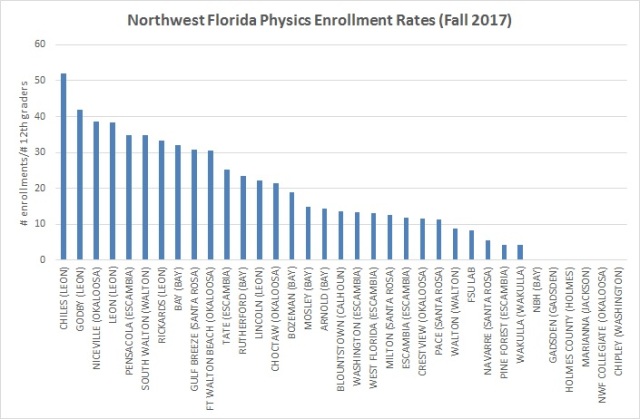Human beings seem to have an enormous capacity for stubbornly defending comfortable mediocrity. I’ve seen two examples of that this week in the context of high school math and science education in Florida.
The first was the announcement from Step Up For Students yesterday that Florida was once again highly ranked in the percentage of students who graduate from high school having passed at least one Advanced Placement exam. Step Up’s Ron Matus and I executed our annual brief twitter dance on the subject. Ron tweeted, “Florida ranks No. 4 (again) in % of high school grads passing AP exams, acc. to new @CollegeBoard report. High ranking means it prolly won’t get much attention (again).” I responded with “It’s important to note that while Florida is a national leader in AP exams in the social sciences, the state is only average in AP math and science.” And I included the plot shown below to illustrate the point.

Ron responded as he always does, “Only average is still better than many people’s perceptions of FL schools & not bad considering far-above-average challenges with FL demographics. But it’s clearly not good enough. Would be nice if this got more attention – and coverage.” [Editor’s note: It got coverage in the Orlando Sentinel ]
In past years when Ron and I have had exactly the same exchange, I let it go and moved on. Ron was doing his job, and I had said what I had to say.
But this time, I can’t seem to let it go. Ron was arguing that it’s important to celebrate high achievement in non-STEM subjects, but that we should be willing to accept average performance in STEM subjects because of Florida’s demographic challenges. Ron is applying a double standard to student learning – it’s OK to be mediocre in the math and science subjects that provide a foundation for the 21st century’s most financially secure careers as long as students show that they can remember a lot of stuff they read in a social studies textbook.
Ron is not alone in this. Jeb Bush proclaimed Florida to be the “Just Read!” state, and the state has taken that to heart for nearly two decades by deemphasizing math and science.
Now a personal note (as if this hasn’t been too personal already): There is not a mediocre cell in Ron’s body. You may love him, and you may hate him (and apparently some do). But I know Ron well enough to know that he is focused on doing whatever he’s doing as well as it can be done and that he cares deeply about Florida’s students. Given all that, his public defense of mediocrity in math and science is ironic.
My second example of the defense of mediocrity comes from Panama City’s Bay High School, which is unhappy with my blog post ranking Northwest Florida’s 35 largest high schools in chemistry, physics and calculus and made its displeasure known with a video they posted on their Facebook page. Their focus was a defense of their chemistry enrollment rate, which at 37 enrollments per 100 12th graders is far behind the average for the region and the state (as shown in the graph below). According to the guidance counselor who narrated the video, the students who are not in the school’s AICE program ordinarily take a physical science course, the state’s required Biology 1 course, and a course in anatomy and physiology – and not a chemistry class at all. That would certainly account for the school’s low chemistry enrollment rate. It’s also worth noting that the narrator admitted that a substantial number of students in the AICE program – about one-fifth – graduate without chemistry, either. But instead of apologizing, the narrator sold this as a feature of Bay High School’s program and not a bug.
Is it OK for most of the school’s students not to take chemistry? This is unusual, even for a Florida high school. And it’s not even typical of Bay County. Three of the district’s high schools – Bozeman, Mosley and Rutherford – are among the region’s leaders in chemistry enrollment rate.
What makes Bay High School’s defense of its chemistry situation even more odd is the success it has had in enrolling 9th graders in physics classes – primarily the Pre-AICE physics class. Bay’s physics enrollment rate of 32 enrollments per 100 12th graders is among the region’s top ten.
The context for the Bay High School video is important. Bay County’s high schools compete to enroll college-bound 8th graders in their “advanced” programs. Bay’s AICE program competes with Rutherford’s IB program, the Mosley Advanced Placement Program for Success (MAPPS), and Arnold High School’s Collegiate Studies program. The video defending the chemistry enrollment rate was a recruiting video intended as a response to the success that Mosley had last year by emphasizing math and science rigor in its recruiting message. Math and science have become the battleground on which Bay County’s high schools are competing for college-bound 8th graders, and that is a good thing.
Parents are the ultimate deciders, and the parents of Bay County’s college-bound 8th graders will decide whether they want their children in a school where STEM rigor is expected such as Bozeman, Mosley and Rutherford or whether they prefer more STEM flexibility, as at Bay.


